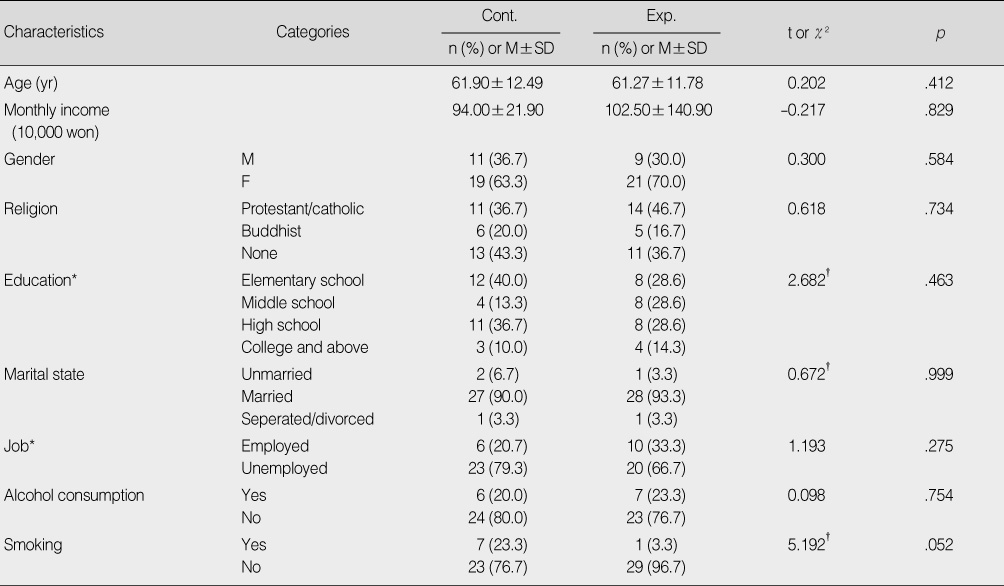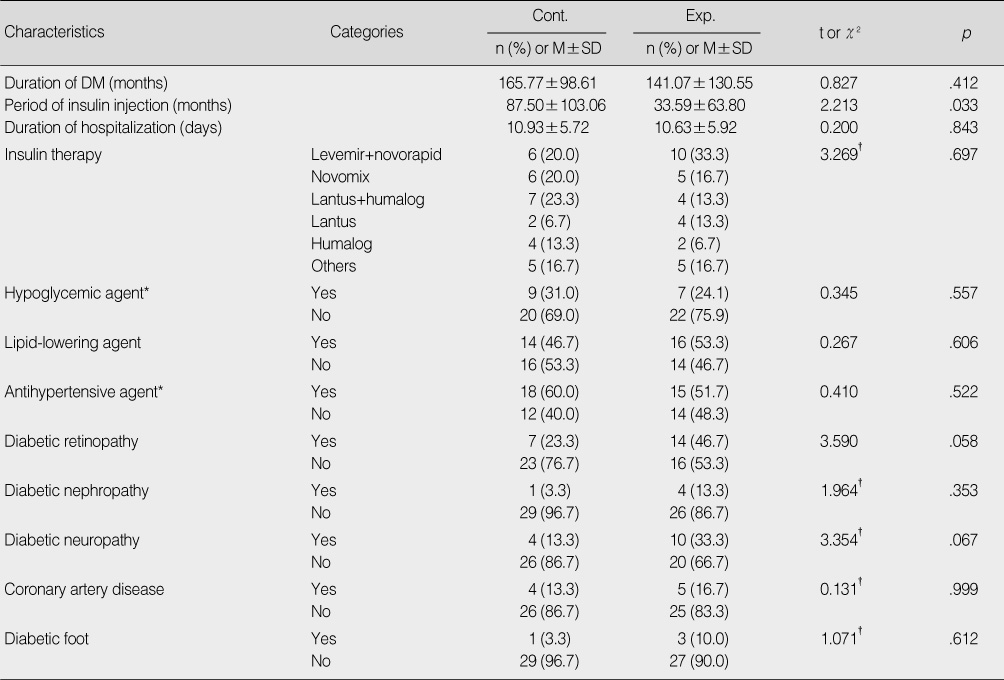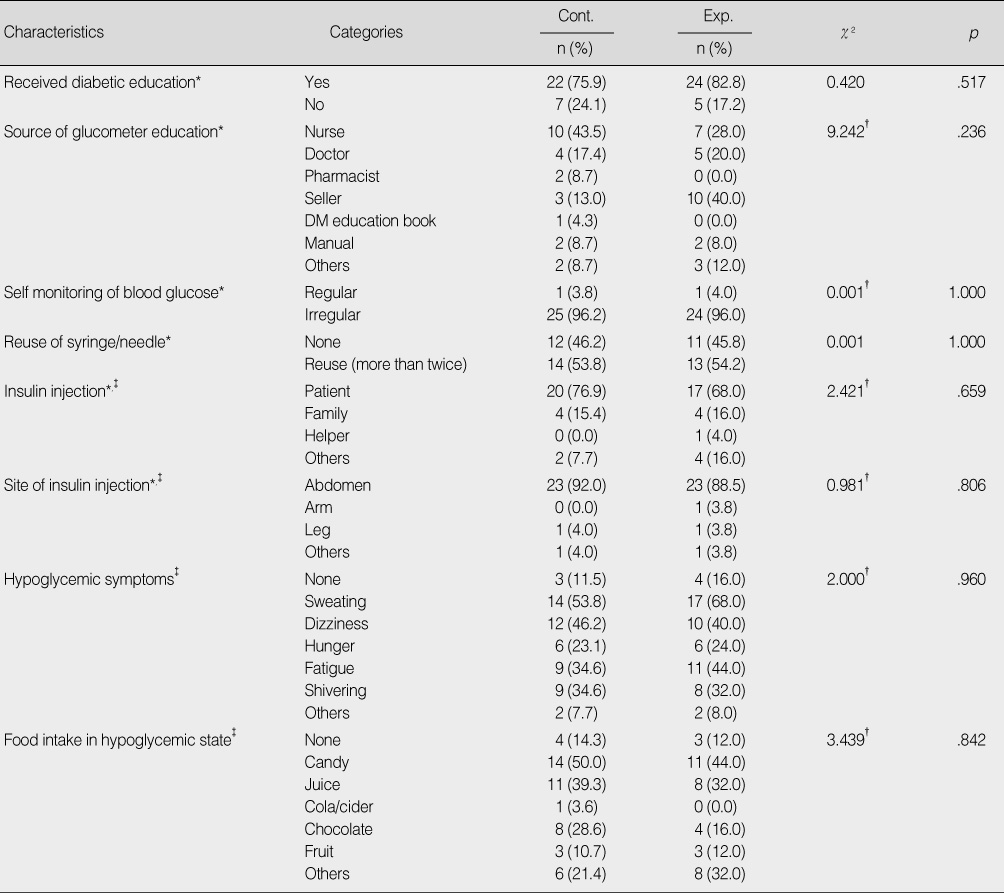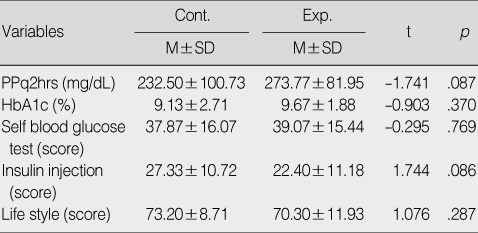Articles
- Page Path
- HOME > J Korean Acad Nurs > Volume 39(5); 2009 > Article
-
Original Article
- The Effects of Tailored Diabetes Education on Blood Glucose Control and Self-Care
- Kyung Sun Hyun, Kwang Mi Kim, Sook Hee Jang
-
Journal of Korean Academy of Nursing 2009;39(5):720-730.
DOI: https://doi.org/10.4040/jkan.2009.39.5.720
Published online: October 31, 2009
1Professor, College of Nursing Science, East-West Nursing Research Institute, Kyung Hee University, Korea.
2Head Nurse, Kyung Hee Medical Center, Korea.
3Diabetes Educational Nurse, Kyung Hee Medical Center, Seoul, Korea.
- Address reprint requests to: Hyun, Kyung Sun. Department of Nursing Science, Kyung Hee University, 1 Hoegi-dong, Dongdaemun-gu, Seoul 130-701, Korea. Tel: 82-2-961-9424, Fax: 82-2-961-9398, hks@khu.ac.kr
Copyright © 2009 Korean Society of Nursing Science
Abstract
-
Purpose
- The purpose of this study was to test the effects of tailored diabetic education on blood glucose control and self-care for patients with type 2 diabetes on insulin therapy.
-
Methods
- The participants were 60 patients (experimental group: 30, control group: 30) with type 2 diabetes on insulin therapy. The patients were being seen at a university hospital in Seoul, Korea. Group diabetic education and tailored diabetic education were given to the experiment group while group diabetic education only was given to the control group. Data were collected before and three months after the education. χ2 test, t-test, and ANCOVA were used to analyze the data.
-
Results
- No significant differences in postprandial (PP2hrs) glucose and HbA1c levels were found between the two groups. Participants in the experiment group showed statistically significant differences in the area of self-glucose test, management of insulin injection, and life style change compared to those in the control group.
-
Conclusion
- The results indicate that tailored education for patients with diabetes on insulin therapy improve self-glucose test, management of insulin injection, and life style. Therefore it is suggested that tailored education can be applied in diabetic education to improve self-care.
- 1. Black JM, Hawks JH. Medical-surgical nursing: Clinical management for positive outcomes. 2005;7th ed. St. Louis, MO, Elservier Saunders.
- 2. Chae YH, Son SK. Effects of individual nursing education on self-efficacy and sick-roll behavior in diabetes patients. The Journal of Korean Academic Society of Nursing Education. 2000;6:103–114.
- 3. Choe MA, Kim KW. English-Korean Mosby's medical, nursing & allied health dictionary. 2002;6th ed. Seoul, Hyunmoonsa.
- 4. International Diabetes Federation. Global guideline for Type 2 diabetes. 2005;Belgium, Paperland Printers Publishing.
- 5. Jun JY. A study on the experience of self-care in diabetic patients with complication. Journal of Korean Academy of Adult Nursing. 1996;8:244–263.
- 6. Kim CG, Chung CH. Effects of telephone consulting program on self-efficacy and self-care in NIDDM patients. Journal of Korean Academy of Adult Nursing. 2002;14:306–314.
- 7. Kim HJ, Kim HS, Ahn SH. Effects of diabetic education fortified with individual practice on plasm glucose, self-care, and self reported physical symptom in type 2 diabetic patients. Journal of Korean Academy of Adult Nursing. 2006;18:194–201.
- 8. Kim HS. Effects of web-based diabetic education in obese diabetic patients. Journal of Korean Academy of Nursing. 2005a;35:924–930.ArticlePubMedPDF
- 9. Kim HS. Effects of internet diabetic education on blood glucose in hyperglycemic patients. Journal of Korean Academy of Adult Nursing. 2005b;17:444–451.
- 10. Ko CH, Gu MO. The effects of a diabetic educational program for coping with problem situation on self-efficacy, self care behaviors, coping and glycemic control in type 2 diabetic patients. Journal of Korean Academy of Nursing. 2004;34:1205–1214.ArticlePubMedPDF
- 11. Korean Association of Diabetic Nurse Educators. Diabetic patient guidebook. 2002;Seoul, Author.
- 12. Korean Association of Diabetic Nurse Educators. The future of diabetic education. Paper presented at the meeting of the Korean Association of Diabetic Nurse Educators. 2008;02;Seoul, Korea.
- 13. Korean Diabetes Association. Treatment Guideline for Diabetes. 2007;Seoul, MMK Communications.
- 14. Korean Diabetes Association. Health Insurance Review & Assesment Service. Diabetes in Korea 2007. 2007;Seoul, SIKR Publishing.
- 15. Lee EO, Lim NY, Park HA. Nursing medical research and statistical analysis. 1998;3rd ed. Seoul, Soomoonsa.
- 16. Lee HJ, Park KT, Park HS, Kim IJ. The effects of problem solving nursing counseling and intensified walking exercise on diabetic self care, coping strategies, and glycemic control among clients with DM type II. Journal of Korean Academy of Nursing. 2005;35:1314–1324.ArticlePubMedPDF
- 17. Lee JS, Ro SO, Shin DS, Kim MH, Jung YM. The experience of life in with diabetics. Journal of Korean Academy of Nursing. 2000;30:1219–1229.ArticlePDF
- 18. Lewis SM, Heitkemper MM, Dirksen SR, O'brien PG, Giddens JF, Bucher L. Medical-surgical nursing: Assessment and management of clinical problems. 2004;6th ed. St. Louis, MO, Mosby.
- 19. Lim S, Kim DJ, Jeong IK, Son HS, Chung CH, Koh G, et al. A nationwide survey about the current status of glycemic control and complication in diabetic patients in 2006-The committee of the Korean diabetes association on the epidemiology of diabetes mellitus-. Korean Diabetes Journal. 2009;33:48–57.
- 20. Park JH, Kim KW, Kang EJ, Kim TY, Lee SR, Bae SC, et al. Evaluation of glycemic control in type 2 diabetic patients have been treated in general hospital. Journal of Korean Diabetes Association. 2004;28:208–218.
- 21. Park KY, Park HS, Seo JM. The effects of a cognitive behavioral stress management program on diabetic self-care and glycemic control with diabetes mellitus type II. Journal of Korean Academy of Adult Nursing. 2007;19:683–693.
- 22. Polonsky WH, Earles J, Smith S, Pease DJ, Macmillan M, Christensen R, et al. Integrating medical management with diabetes self-management training: A randomized control trial of the diabetes outpatient intensive treatment program. Diabetes Care. 2003;26:3048–3053.PubMed
- 23. Yoo JS, Kim EJ, Lee SJ. The effects of a comprehensive life style modification program on glycemic control and stress response in type 2 diabetes. Journal of Korean Academy of Nursing. 2006;36:751–760.ArticlePubMedPDF
- 24. Yoo JW, Suh MJ. Analysis of insulin injection focused self-care and related factors in diabetes. Journal of Korean Diabetes Association. 2003;27:153–164.
REFERENCES
Figure & Data
REFERENCES
Citations

- Designing a Self-Care Integrated Protocol and Evaluating its Validity in Type 2 Diabetic Patients; the Case of a Single Subject
Susan Salary, Rasul Roshan, Hamid Pour Sharifi, Hojjatollah Farahani
Health Research Journal.2021; 7(1): 1. CrossRef - Self-Management Nursing Intervention for Controlling Glucose among Diabetes: A Systematic Review and Meta-Analysis
Mi-Kyoung Cho, Mi Young Kim
International Journal of Environmental Research and Public Health.2021; 18(23): 12750. CrossRef - Assessment of type 2 diabetes patients’ self-care status learned based on the national diabetes control and prevention program in health centers of a selected city, Iran
Roghayeh Ershad Sarabi, Zahra Mokhtari, Ahmad Naghibzadeh Tahami, Vahid Reza Borhaninejad, Ali Valinejadi
Koomesh journal.2021; 23(4): 465. CrossRef - The Effects of a Self-care Management Program for Patients with Diabetic Foot Ulcers
Jung Yoon Kim, Eui-Young Cheon
Journal of Korean Biological Nursing Science.2016; 18(2): 78. CrossRef - Group based diabetes self-management education compared to routine treatment, waiting list control or no intervention for people with type 2 diabetes mellitus
Aslak Steinsbekk, Lisbeth Ø. Rygg, Monde Lisulo, Marit By Rise, Atle Fretheim
Cochrane Database of Systematic Reviews.2015;[Epub] CrossRef - Effects of Individual and Group Education Programs on Coping and Self-care Behaviors in Cancer Patients
Young Mi Kim, Won Ock Kim, Sang Sook Han
Journal of East-West Nursing Research.2014; 20(1): 1. CrossRef - Development of a Comprehensive Self-Management Program Promoting Self Efficacy for Type 2 Diabetic Patients
Ju-Young Park, Il-Sun Ko
Journal of Korean Academy of Fundamentals of Nursing.2012; 19(1): 74. CrossRef - Investigation of Effect on Glycosylated Hemoglobin, Blood Pressure, and Body Mass Index of Diabetes Intensive Education Program in Patients With Type 2 Diabetes Mellitus
Emel Beyazıt, Mukadder Mollaoğlu
American Journal of Men's Health.2011; 5(4): 351. CrossRef
Homogeneity Test of General Characteristics between Experimental and Control Groups
*Missing data were excluded; †Fisher's exact test.
Cont.=control group (n=30); Exp.=experimental group (n=30).
Homogeneity Test of Disease-related Characteristics between Experimental and Control Group
*Missing data were excluded; †Fisher's exact test.
Cont.=control group (n=30); Exp.=experimental group (n=30).
Homogeneity Test of Self-Care related Characteristics between Experimental and Control Group
*Missing data were excluded; †Fisher's exact test; ‡Multiple answers were allowed.
Cont.=control group (n=30); Exp.=experimental group (n=30).
Homogeneity Test of Outcome Variables before Education
Cont.=control group (n=30); Exp.=experimental group (n=30); PPq2hrs=2 hr post-prandial blood glucose; HbA1c=glycosylated hemoglobin.
Mean Differences of Outcome Variables between Experimental and Control Groups
*F value of ANCOVA with period of insulin injection and pre-test score as covariates.
Cont.=control group (n=30); Exp.=experimental group (n=30); PPq2hrs=2 hr post-prandial blood glucose; HbA1c=glycosylated hemoglobin.
*Missing data were excluded; †Fisher's exact test. Cont.=control group (n=30); Exp.=experimental group (n=30).
*Missing data were excluded; †Fisher's exact test. Cont.=control group (n=30); Exp.=experimental group (n=30).
*Missing data were excluded; †Fisher's exact test; ‡Multiple answers were allowed. Cont.=control group (n=30); Exp.=experimental group (n=30).
Cont.=control group (n=30); Exp.=experimental group (n=30); PPq2hrs=2 hr post-prandial blood glucose; HbA1c=glycosylated hemoglobin.
*F value of ANCOVA with period of insulin injection and pre-test score as covariates. Cont.=control group (n=30); Exp.=experimental group (n=30); PPq2hrs=2 hr post-prandial blood glucose; HbA1c=glycosylated hemoglobin.
 KSNS
KSNS
 E-SUBMISSION
E-SUBMISSION





 Cite
Cite

